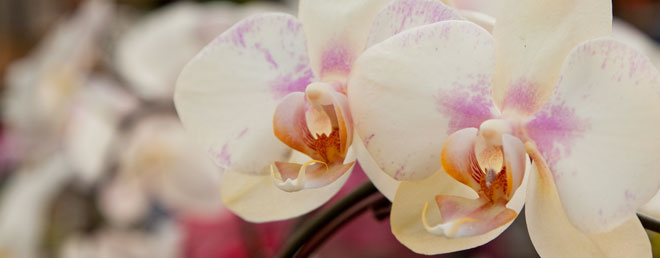Growing Orchids Isn’t as Scary as you think
by Rob Sproule
Few plants capture our imagination, delight, and awe like an orchid. Whether it’s their deliciously symmetrical beauty or their tantalizing rarity, orchids bring presence and pride into the home like no other houseplant can.
When it comes to taking care of orchids, our fascination often leads to unnecessary anxiety. Many people think that they are like a stained glass window and will shatter when touched or moved. The reality is that they are surprisingly rugged.
Type of Orchids
The Orchid family is one of the largest in the plant kingdom and, as anyone who has seen the excellent Edmonton Orchid Show would agree with, contains a host of exotic and sometimes downright unbelievable delights. You can find out more about the 2012 Orchid Show, which runs February 24-26, at www.orchidsalberta.com.
Only a few genus of orchids are both easy to grow and long blooming enough to have become widespread as hybridized houseplants. Of these, the most popular by far is the Phaleanopsis orchid, nicknamed “Moth” for its characteristic winged leaves.
Moth Orchid Basic Care
Moth orchids have skyrocketed to popularity in the past few years thanks to long lasting blooms and surprising ease of care. Unlike most species, they like generally the same temperature that we do and although they normally bloom for a few months, I’ve had one bloom repeatedly for almost 2 years.
When you’re choosing your orchid, make sure the leaves are stiff, dark green, and healthy. Make sure the air roots (the ones sticking up out of the potting medium) have light green tips. Like every plant, there are growers who take their time and grow them properly and those who cut corners.
General Care
Moth orchids prefer to be on the dry side. The surface of the medium (usually moss or bark) should be quite dry before watering again. When you do water, soak it well with room temperature water (I usually do it in the sink) and make sure it’s well drained before you put it back as they hate wet feet. Watering once a week is usually enough, with slightly more from spring to fall and slightly less in the winter.
In their native jungles of Asia and northern Australia, these orchids grow in the tree branches of humid, lowland forests where they are well shaded. In your home, this translates into the indirect light of the average household. If you do put them by a south or west window, keep them at least a foot from the glass and watch for brown scorching on the leaves.
While many orchid species demand high temperatures to grow and/or extreme temperature changes in order to bloom, Moths thrive at common household conditions. They love being between 21 and 24 C during the day and 16 to 19 C at night. My wife and I have ours in a sheltered spot in our sunroom where the windows slightly increase the daily highs and the nightly lows.
Orchids don’t need a lot of fertilizer. Being epiphytic (they grow in trees and not in soil), they are used to being soaked with rain instead of their roots sitting in the earth. Fertilize monthly at half the recommended dosage with a balanced (20-20-20) or an orchid specific mix.
Re-blooming your Orchid
I’ve lost track of how many people I’ve talked to at the greenhouse who bought their orchid thinking it would bloom for a week only to have it bloom for a year. It’s not uncommon if you select one with as many buds as possible.
When it’s finally done blooming, don’t cut off the flower spike. Cut it just above the highest node (the joints in the spike), and it will often spike again. I’ve seen Moths bloom 3 times on the same spike, although they may need staking because they get so high.
In order to trigger orchids to re-bloom they need a slightly higher temperature differential between day and night. Move your orchids closer to a window, watching for direct sunlight which may burn it. Windows, especially old ones, get cooler at night and warmer during the day.
















